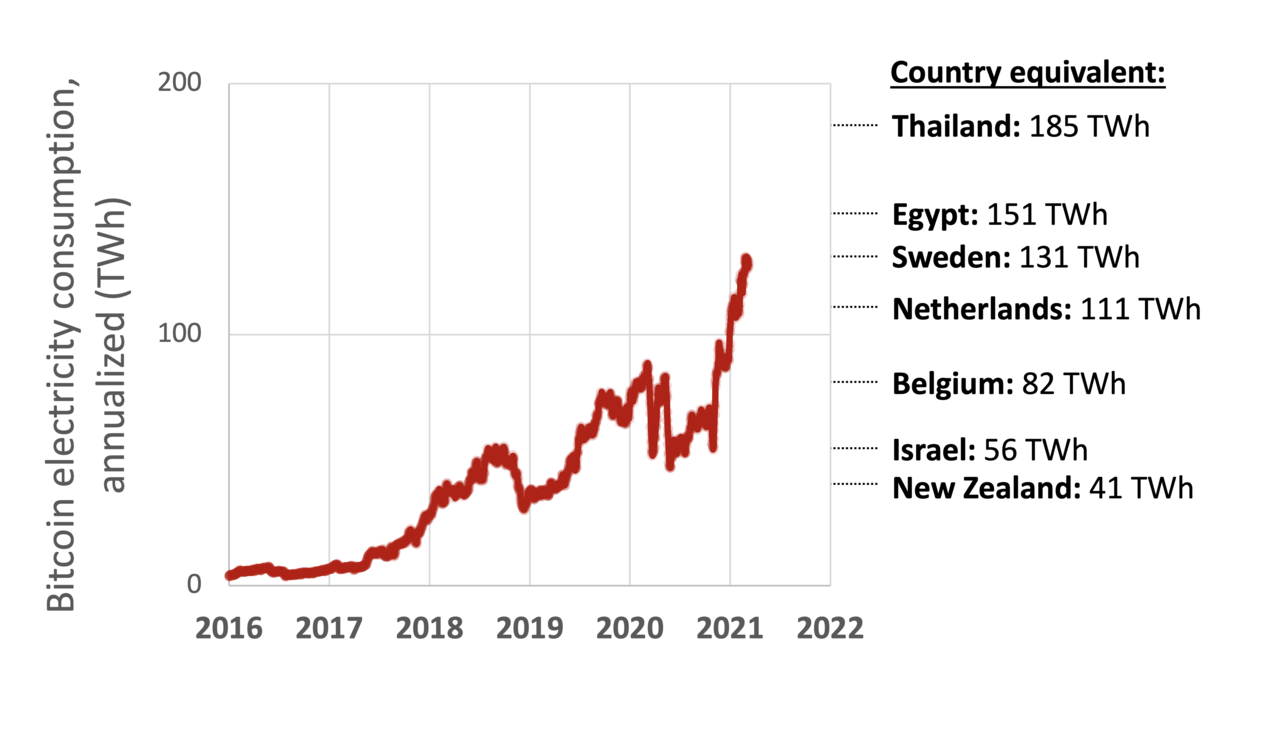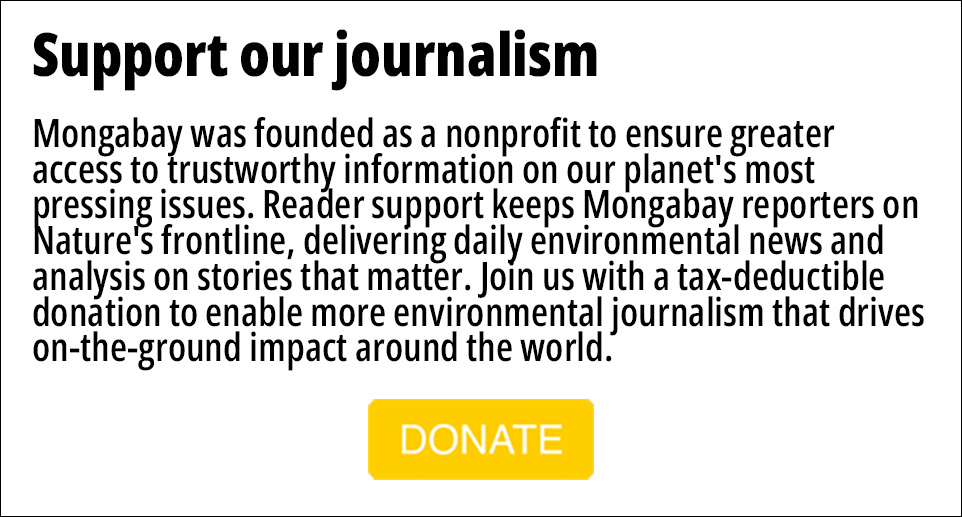Blockchain is polarizing the wildlife community
- Blockchain technology’s various applications, such as NFTs and smart contracts, are being explored for use in wildlife conservation.
- The technology’s potential may be enormous, but drawbacks such as a massive carbon footprint and imposition of Western technology to dictate resource management in the Global South raise logistical and ethical questions.
- Most advocates and critics agree on one thing: the technology is still in the early stages for its applications to be fully understood and implemented on the ground.
How do you raise funds for wildlife conservation in the most 21st century of ways? Non-fungible tokens, or NFTs.
In the northeastern forests of South Africa, Wild Funds Tomorrow, a US-based non-profit organization, has done just that. Since 2017, the organization has been trying to raise funds to buy land, remove fences and clear vegetation to connect two protected areas – MunYaWana Conservancy and iSimangaliso Wetland Park – to allow species such as elephants, rhinos and lions to move freely between landscapes, which which has not been possible for many years. Of the $1.5 million raised so far, $30,000 was raised by WildCards, a South African platform that brings together wildlife conservation and blockchain technology.
In WildCards, animals are represented as unique pieces of digital art, similar to the “Bored Ape” series of NFTs, some of which sold for close to $3 million during the ether’s peak last year. And as with the Bored Ape NFTs, WildCards can be bought and sold using ether, the cryptocurrency native to the Ethereum blockchain platform. The owner of each card acts as a guardian for the animal, paying a predetermined amount each month to the conservation agency protecting the animal or species represented on the card. Since launching in 2019, the WildCards platform has engaged with blockchain, cryptocurrency and NFT enthusiasts to raise approximately $77,000 (until July 26, 2022), with the funds distributed to grassroots conservation organizations around the world, including in countries such as Kenya, India and Malaysia.
“WildCards imbues people’s commitment to wildlife conservation in a fun and playful way,” WildCards co-founder Jason Smythe, a software developer, tells Mongabay in a video interview. “It does that through technology that removes middlemen who charge fees.”

Although NFTs and blockchain, the technology behind them, remain unclear to many, their applications are being explored in various spheres: from secure money transfers to storing land ownership data, among others. Particularly in wildlife conservation, the immutable and transparent nature of the technology means it can be used not only to collect money, but potentially to enforce contracts as well as to track and trace the wildlife trade. However, blockchain technology’s excessive energy consumption and unavailability may be some of the significant drawbacks of its large-scale application. The technology’s fledgling nature also makes many ignorant and suspicious of its use.
Smythe acknowledges the downsides, but says the nascent nature of the technology means much is likely to change in the coming years. “The technology isn’t ossified yet. It’s like listening to someone talk about what the future of the internet is like in the ’90s,” he says. “The experimentation that’s going to happen over the next few decades is going to be interesting.”
Peter Howson, senior lecturer in international development at Northumbria University in the UK, says he was initially excited about the use of blockchain technology for conservation purposes. But over time he has become more skeptical.
First, the carbon footprint of the technology outweighs any benefits it may bring to wildlife conservation. According to the Cambridge Bitcoin Electricity Consumption Index, the mining of bitcoin, the world’s largest cryptocurrency and currently blockchain technology’s most popular application, consumes 92 terawatt hours of electricity each year – much higher than the electricity consumption of countries such as Venezuela, Belgium or Finland. “By using this technology, you are legitimizing an incredibly environmentally destructive industry, which is the crypto industry,” Howson tells Mongabay in a video interview. “This is definitely not an appropriate way to finance a just transition to a green economy.”

The control of technology by a few technocrats and entrepreneurs in the Global North has also raised questions, especially in the context of its use to dictate how resources are managed, distributed and used in the Global South. Aside from fundraising for projects, Howson says, he has yet to see any compelling examples illustrating how blockchain technology can help wildlife conservation. “Most crypto people have a hammer and they’re looking for nails to hit,” he says. “The starting point should be the people who do the social and conservation work. Don’t start with the technical solution.”
Daniel Oberhauser shares the same view: that the starting point should be an analysis of the reality on the ground and potentially adapt the technology accordingly, if it seems like a good fit. During his research work at the University of Oxford in 2019, Oberhauser came up with a prototype that uses smart contracts, another application of blockchain technology, to facilitate a more efficient and transparent system for making payments for ecosystem services (PES).
Smart contracts are programs that perform automated transactions based on certain predetermined conditions. For example, if the contract requires a payment to be made upon completion of a task, it will make the payment automatically as soon as it confirms that the task has been completed. Oberhauser’s prototype uses this mechanism to ensure that a particular individual or community is paid for the services they provide for environmental and wildlife conservation.
Payment for ecosystem services, or PES, is often used as an incentive to get communities involved in conservation efforts, but inefficient financial systems and corrupt management on the ground mean that payments often do not reach beneficiaries on time or in full – or at all times. Oberhauser’s Blockchain for Ecosystem Payments prototype aimed to remove the middlemen through which these leaks can occur, and use smart contracts to ensure transparent payments. The idea was to use Google Earth Engine to monitor whether a particular forest was maintained or whether a species remained protected. If these conditions were met, the smart contract would automatically execute the payment transaction. The smart contract’s inherent features make it transparent and difficult to tamper with.
However, challenges arose when ground realities hit. Who will decide how the benefits are shared? How will recipients in the Global South receive payments through a technology that is mostly unavailable to them? A 2019 article published by Oberhauser in the journal Limits in Blockchain found that unavailability of the technology would necessitate “heavy reliance on trusted intermediaries” — essentially bringing in a new group of intermediaries and negating the decentralized nature of blockchain technology. As a result, the prototype was never implemented on the ground.

Since his paper was published, Oberhauser says, little has changed. He emphasizes the need to integrate technology with governance and politics at ground level. “People who have an understanding of the technology are usually engineers or entrepreneurs from the West who usually have no idea about the governance and natural resource management on the ground,” Oberhauser tells Mongabay in a video interview. “There is still a gap between people who are knowledgeable in both of these respects.”
Like WildCards’ Smythe, Oberhauser says the technology needs to be better developed and experimented with before it can be used for wildlife conservation. But even that requires treading a fine line. With government and public confidence in conservation eroding globally, any misstep risks undoing years of work.
“It’s about managing expectations,” Howson says, adding that when results aren’t visible, people see conservation as a process to be lied to. “Eventually you’re going to run out of people who trust you.”
Banner image: Elephants in iSimangaliso Wetland Park, South Africa. Image by Bernard DUPONT via Flickr (CC BY-SA 2.0).
Quotes:
Oberhauser, D. (2019). Blockchain for Environmental Governance: Can Smart Contracts Enhance Payments for Ecosystem Services in Namibia? Frontiers in Blockchain, 2:21.doi:10.3389/fbloc.2019.00021
Prakash, A. (2019). Ideal governance, public policy and the Oxfam scandal: an introduction. Policy forum for non-profit organisations, 10(4). doi:10.1515/npf-2019-0059



